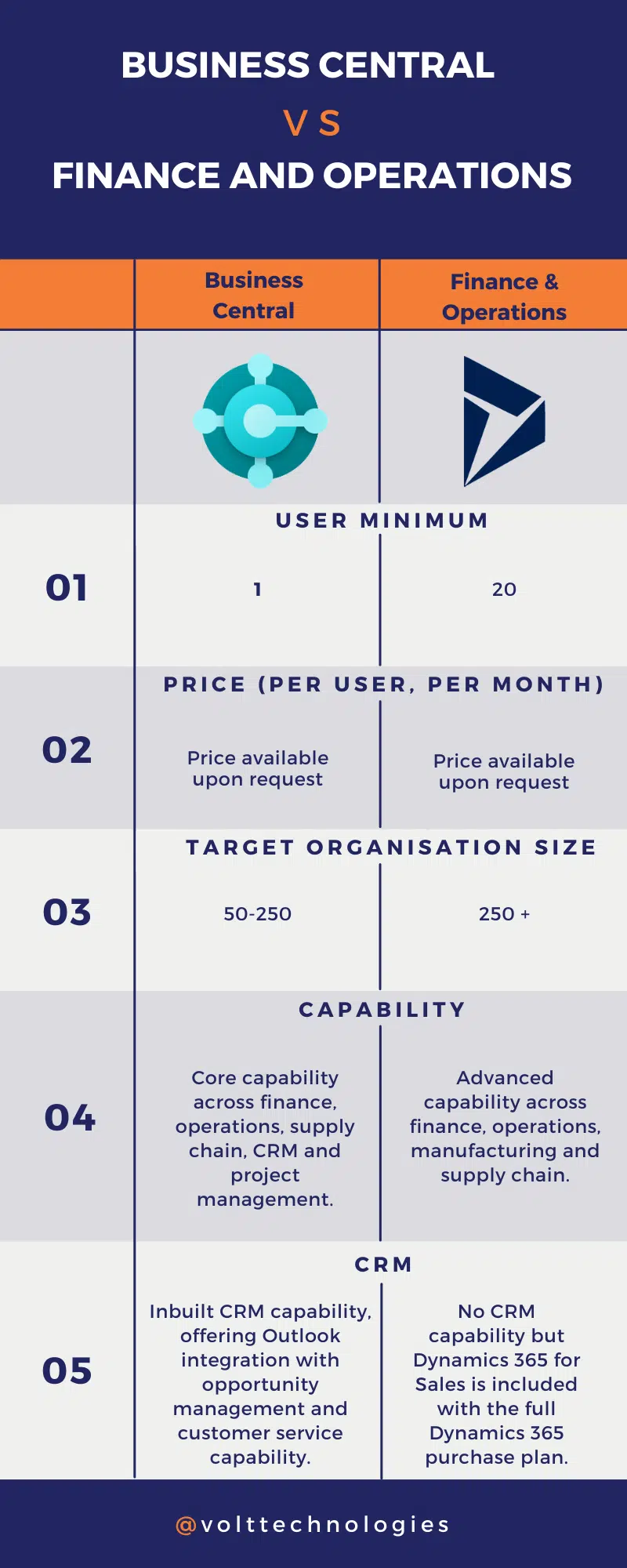Business Central vs Finance and Operations


About Author
Mason Whitaker
Microsoft Dynamics 365 | Simplify your IT footprint and make decisions faster.
Why is it that Microsoft has 2 ERP systems? What are their different capabilities? Their price? Their implementation strategy?
That's what I'm here to help answer for you.
Businesses are nothing without their systems.
Think about it.
When you get down to the core of what makes any business thrive, you’ll quickly see that without the systems created by their founders & everyday workers there is nothing left but ideas. How we collect revenue, pay our expenses, and procure our inventory, the collection of these processes makes or breaks a business.
This is why it is critical to provide your business with an intelligent system that promotes best practices and enhances operational efficiency as opposed to stifling that efficiency.
That’s where Microsoft Dynamics 365 comes in.
Dynamics 365 is a portfolio of products that was created by Microsoft to enable organizations to execute all their business operations underneath a single platform. Regardless of what business function, Dynamics 365 has it covered with financials, sales, purchasing, project, warehousing, field service, manufacturing, retail, etc. The list goes on and on in terms of the capabilities served by the overall Dynamics 365 platform.
While there are dozens of applications in the Dynamics 365 family, there are only 2 enterprise resource planning systems (ERPs).
Business Central (BC) is an ERP that Microsoft deployed specifically for the small to mid-size market (which internally we classify as ~500K -> ~150M in annual revenue) while Finance & Operations (F&O) was deployed for the large to enterprise market (~150M+ in annual income).
Business Central and Finance & Operations both are end-to-end integrated ERP solutions with modules covering Financials, Sales, Purchasing, Warehousing, Manufacturing, Projects, and much more; however, they differ in their capabilities, capacity, price, and implementation strategy.
Capabilities
Since Business Central was created for the small to mid-size market, it contains less functionality than that of Finance & Operations.
Business Central contains all the core functionality that is required for small to mid-size companies to operate their business efficiently without the added systemic complexity that is required by more giant corporations.
For example, Business Central and Finance & Operations both have the functionality to track and move inventory at a location/bin level within a warehouse.
However, Finance and Operations give you out of the box the ability to use mobile devices, optimize picking routes, consolidate loads, and many other things that smaller companies don’t necessarily need. Business Central users can still add these functionalities, but it may require an extension or possible integration with a third-party provider.
These are just a few examples of how Business Central and Finance & Operations differ in their capabilities. Still, it is easy to remember that Business Central has all the breadth of Finance & Operations, but not the same amount of depth in terms of capabilities.
However, that depth comes at a cost.
PRICING
Starting at $70 a month per user with a minimum requirement of only a single user to get started, Business Central has one of the lowest cost barriers of any ERP on the market today, certainly lower than that of Finance & Operations.
Finance & Operations licenses start at $180 a month per user with a minimum requirement of 20 users, which is a floor price of $3,600 a month to get in the door.
The licenses are not the only area where Business Central and Finance & Operations differ in terms of price, these differences also exist on the implementation side as well.
Due to Business Central’s “no-fluff” approach, implementations are fast-paced and focused on change management and end-user adoption as opposed to system configuration. This drastically cuts down the implementation timeline and makes it easier for the Microsoft partner to implement. On average, Business Central projects take 4-6 months from project kickoff to end users’ live operation in production. Depending on what capabilities are required from the implementation, some projects only take a matter of a few weeks and are offered as packages as opposed to normal bi-weekly consulting billing.
Finance & Operations projects have longer lead times for configuring and deploying to ensure that the company’s current business processes are mapped into the system as there is more functionality that is required to implement. This approach is focused on ensuring a company’s current business processes are mapped into the system and requires deep expertise in the Finance & Operations systems to map. Thus, this implementation style inherently comes with a heavier price tag, and average implementations last between 9 to 12 months.
CAPACITY
Due to the lower price tag, Business Central does have limitations around the technical capacity of the system. As a general rule, if you are processing hundreds of thousands of transactions in a given month, then it is likely you are not fitted for Business Central. Processing these workloads puts strains on the system and leads to an overall system performance problem which is only solved by upgrading to Finance & Operations.
However, if you are processing just several thousand transactions monthly, you are a good fit for Business Central.
These limits on transactions are not just for performance, but also apply when speaking to the limitations on database size. Business Central tops out at 80GB of ERP storage (with the ability to purchase additional space).
Though this limitation is often mitigated during Business
Central implementations by publishing historical data to an external data warehouse are still something to be aware of when implementing Business Central.
ComPARISON


